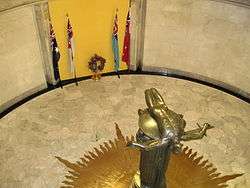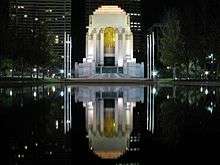ANZAC War Memorial
| ANZAC Memorial | |
|---|---|
| Australia | |
|
ANZAC Memorial, Hyde Park, Sydney | |
| For the AIF dead of World War I | |
| Unveiled | 24 November 1934 |
| Location |
33°52′32.6″S 151°12′39.4″E / 33.875722°S 151.210944°ECoordinates: 33°52′32.6″S 151°12′39.4″E / 33.875722°S 151.210944°E near Sydney, Australia |
| Designed by | Bruce Dellit |
The ANZAC Memorial, completed in 1934, is the main commemorative military monument of Sydney, Australia. It was designed by C. Bruce Dellit, with the exterior adorned with monumental figural reliefs and sculptures by Rayner Hoff.[1]
The memorial is located at the southern extremity of Hyde Park on the eastern edge of Sydney's central business district, and it is the focus of commemoration ceremonies on Anzac Day, Remembrance Day and other important occasions.
It was built as a memorial to the Australian Imperial Force of World War I. Fund raising for a memorial began on 25 April 1916, the first anniversary of the Australian and New Zealand Army Corps (ANZAC) landing at Anzac Cove for the Battle of Gallipoli.[2] It was opened on 24 November 1934 by His Royal Highness Prince Henry, Duke of Gloucester.
Design
A competition for the design of the memorial was commissioned in July 1929 and a month later the prize-winning entries were announced by the Governor of New South Wales, Sir Philip Game. Third prize was awarded to Peter Kaad, second prize to John D. Moore and the winner was Bruce Dellit. The successful contractors for the building works were Kell & Rigby.[3]
The building is constructed of concrete, with an exterior cladding of pink granite, and consists of a massed square superstructure with typically Art Deco setbacks and buttresses, punctuated on each side by a large arched window of yellow stained glass, and crowned with a ziggurat-inspired stepped roof. It is positioned atop a cruciform pedestal within which are located administrative offices and a small museum.
The interior is largely faced in white marble, and features a domed ceiling adorned with 120,000 gold stars – one for each of New South Wales' military volunteers during World War I. Access to the main hall is provided via broad stairways on each side of the building's north-south axis, while ground-level doorways on the east and west sides offer entry to the lower section.
The main focus of the interior is Rayner Hoff's monumental bronze sculpture of a deceased youth, representing a soldier, held aloft on his shield by a caryatid – three female figures, representing his mother, sister and wife. The male figure's nudity was considered shocking at the time of the monument's opening, and it is said to be the only such representation of a naked male form within any war memorial. Two other even more controversial figural sculptures designed by Hoff—one featuring a naked female figure—were never installed on the eastern and western faces of the structure as intended, partly as a result of opposition from high ranking, reactionary local Catholic Church representatives.
The building's exterior is adorned with several bronze friezes, carved granite relief panels and twenty monumental stone figural sculptures symbolising military personnel, also by Hoff.
Immediately to the north of the ANZAC Memorial is a large rectangular "Lake of Reflections" flanked by rows of poplars. The poplars, not native to Australia, symbolise the areas of France in which Australian troops fought. Original plans called for the construction of similar pools on each of the other sides of the building, but these were never built.



Images
-
General view of the memorial's setting in Hyde Park
-

Daytime snapshot of the ANZAC Memorial
-

Detail of monumental sculptures and reliefs
-

Rayner Hoff's Sacrifice inside the memorial
-
Anzac_War_Memorial3.jpg)
Looking up through the 'Well of Contemplation'
-

The Memorial, as seen across the "Lake Of Reflections", by night.
See also
- Australian War Memorial – Australia's national war memorial and museum in Canberra
- Shrine of Remembrance – Melbourne's main war memorial
- Shrine of Remembrance, Brisbane – Brisbane's main war memorial
- Hobart Cenotaph – Hobart's main war memorial
- National War Memorial (South Australia) – Adelaide's main war memorial
References
- ↑ "History". Anzac Memorial. Department of Premier and Cabinet, New South Wales Government. Retrieved 10 October 2015.
- ↑ "Sydney". Anzacday.org.au. Retrieved 9 October 2015.
- ↑ "How the Memorial came into being" Returned and Services League of Australia (NSW), Retrieved 15 February 2012
- ↑ "ANZAC War Memorial Hyde Park". Art Deco Sydney. Archived from the original on 15 February 2008. Retrieved 3 February 2008.
Sources
- Bayer, Patricia, Art Deco Architecture: Design, Decoration and Detail from the Twenties and Thirties, Thames & Hudson, London, 1992
- Edwards, Deborah, This Vital Flesh: The Sculpture of Rayner Hoff and His School, Art Gallery of New South Wales, Sydney, 1999
- Hedger, Michael, Public Sculpture in Australia, Craftsman House, Sydney, NSW, 1995
- Inglis, K.S., Sacred Places: War Memorials in the Australian Landscape, Melbourne University Press, Melbourne, 1998
- Sturgeon, Graeme, The Development of Australian Sculpture: 1788 – 1975, Thames & Hudson, London, 1978
- Van Daele, Patrick and Roy Lumly, A Spirit of Progress: Art Deco Architecture in Australia, Craftsman House, Sydney, NSW, 1997
External links
| Wikimedia Commons has media related to ANZAC War Memorial. |
- Official website
- Anzac War Memorial 3D animation
- The Anzac Memorial Pool of Reflection – Description of the memorial from the City of Sydney website. (Last accessed 2 August 2013)
- Peace Offering that Shocked the Church – A newspaper article that discusses the controversy surrounding the never-installed sculptures Rayner Hoff designed for the Anzac Memorial
- National salute needed for Aussie Diggers – Information on a proposal by the City of Sydney to install the second pond of reflection on the southern side of the memorial as originally intended
- Laila Ellmoos – City of Sydney History Program (2008). "Anzac War Memorial Hyde Park". Dictionary of Sydney. Dictionary of Sydney Trust. Retrieved 7 October 2015. [CC-By-SA]
